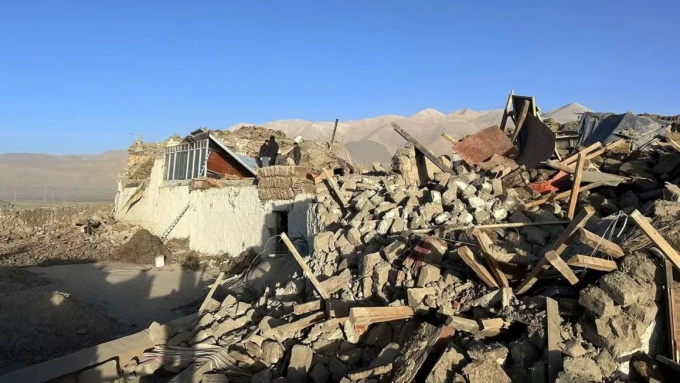
A strong earthquake with a shallow epicenter in an area of isolated communities, rugged terrain, and poorly constructed buildings has resulted in significant casualties.
As of the afternoon of January 7, Chinese authorities reported at least 95 fatalities, 130 injuries, and over 1,000 homes either collapsed or damaged in the earthquake in Tingri County, Tibet.
The China Earthquake Networks Center (CENC) stated that the region frequently experiences earthquakes, but this one was the strongest in the past five years. Neighboring areas, including Nepal, Bhutan, and northern India, also felt strong tremors.
The CENC recorded the quake’s magnitude at 6.8, while the U.S. Geological Survey (USGS) measured it at 7.1. The epicenter was located in Tingri County, about 80 km north of Mount Everest, at a shallow depth of 10 km, according to India Today. USGS classifies earthquakes with an epicenter depth of less than 70 km as "shallow-focus" quakes. Shallow-focus quakes often cause more severe damage than deeper ones.
Susan Hough, a geologist at USGS, compared shallow-focus earthquakes to “detonating a bomb just beneath a city.” According to earthquake expert Phil R. Cummins of the Australian National University, while deeper quakes over 50 km can still cause widespread damage, their intensity tends to diminish as seismic waves travel to the surface.
For example, a 6.5-magnitude earthquake in Tasikmalaya, West Java, in 2017, occurring at a depth of 90 km, resulted in just four fatalities. By contrast, a 5.6-magnitude quake at a depth of 10 km near Cianjur, West Java, on November 21, 2022, caused at least 268 deaths and damaged 22,000 homes, despite releasing significantly less seismic energy than the Tasikmalaya quake.
The Tingri earthquake originated from a geological fault zone in the area, known as the Lhasa Terrane, which experiences compressional forces from the north-south direction and extensional forces from the east-west direction.
The Lhasa Terrane, a significant geological zone in southern Tibet, lies between the Bangong-Nujiang Suture Zone to the north and the Indus-Yarlung Zangbo Suture Zone to the south. It is continually impacted by tectonic collisions between the Indian and Eurasian plates, processes that have contributed to the formation of the Himalayas and influence fault systems and seismic activity in the region.
Since 1950, the Lhasa Terrane has experienced 21 earthquakes with magnitudes of 6.0 or higher, the strongest being a 6.9-magnitude quake in Mainling in 2017, according to CCTV.
Local residents in Tingri reported significant damage, partly due to the area's fragile housing structures. Sangji Dangzhi, 34, who owns a supermarket in Tingri, described the situation as "very severe," with ambulances continuously transporting the injured to hospitals.
"Houses here are built with mud, so when the earthquake struck, many collapsed," said Dangzhi, who had returned from Shigatse after the quake.
Roughly an hour after the main quake, the area experienced numerous strong aftershocks, one measuring 4.4, according to Xinhua. The Chinese government reported nearly 50 aftershocks in the hours following the main quake.
The region near the epicenter is sparsely populated but features many small villages scattered across remote valleys, separated by rugged terrain that is often difficult to access. Approximately 6,900 people are estimated to live in 27 villages within a 20-km radius of the epicenter. The nearest major city is Shigatse, about 180 km away, with a population of approximately 800,000.
Chinese President Xi Jinping has called on authorities to maximize search and rescue efforts, minimize casualties, provide shelter for affected residents, and ensure the safety and warmth of those who have lost their homes.
More than 1,500 firefighters and local rescue personnel have been deployed to the affected areas. Around 22,000 relief items, including cotton tents, jackets, blankets, and folding beds, have also been dispatched to the earthquake zone. The Chinese Air Force has launched rescue operations and deployed drones to the impacted areas.
Jiang Haikun, a researcher at CENC, told CCTV that there is a possibility of another 5.0-magnitude earthquake in the area but that a stronger quake is unlikely.
(Sources: CNN, AFP, India Today, Reuters)
Hello Shuttle will strive to bring the latest updates. At the end of the day.
Are you looking for reliable airport and cruise port transfer services in Los Angeles?
We offer professional, safe, and punctual transportation from
Los Angeles Airport - LAX
Long Beach Airport - LGB
John Wayne Airport - SNA
San Pedro cruise port
Long Beach cruise port
Disneyland
and other destinations.
Let us make your journey stress-free and comfortable with our dedicated drivers and high-quality vehicles. Book now for the perfect travel experience at www.helloshuttle.com or call 944-800-5678!


